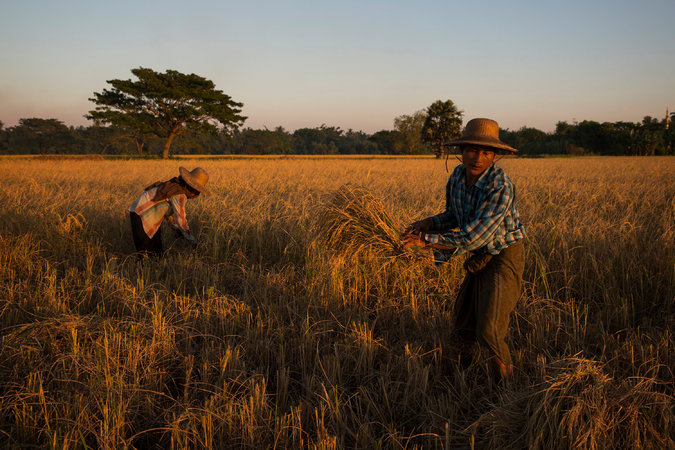Drought and Heat Took a Heavy Toll on Crops, Study Finds
ENVIRONMENT, 11 Jan 2016
Nicholas St. Fleur – International New York Times

Harvesting rice in Myanmar in November. Researchers looked at 2,800 weather disasters and data on 16 different cereal crops. Credit Adam Dean for The New York Times
6 Jan 2015 – Droughts and heat waves wiped out nearly a tenth of the rice, wheat, corn and other cereal crops in countries hit by extreme weather disasters between 1964 and 2007, according to a new study.
The paper, published Wednesday in Nature, examined data on the effects, over five decades, of extreme temperatures, floods and droughts on national crop harvests.
“People already knew that these extreme weather events had impacts on crop production,” said Navin Ramankutty, a geographer from the University of British Columbia and an author of the report. “But we didn’t know by how much, and we didn’t have a basis for how that might change in the future.”
Dr. Ramankutty and his team combined data from a disaster database with food production information from the United Nations Food and Agriculture Organization. They looked at about 2,800 weather disasters, such as the 1983-1984 drought in Ethiopia and the 2003 European heat wave, along with data on 16 different cereals, including oats, barley, rye and maize, grown in 177 countries.
Short Answers to Hard Questions About Climate Change – The issue can be overwhelming. The science is complicated. We get it. This is your cheat sheet.
They found that droughts cut a country’s crop production by 10 percent, and heat waves by 9 percent, but that floods and cold spells had no effects on agricultural production levels. His team estimated a loss of more than three billion tons of cereal production from 1964 to 2007 as a result of droughts and heat waves.
“We don’t think about it much, but rice, wheat and maize alone provide more than 50 percent of global calories,” Dr. Ramankutty said. “When these grain baskets are hit, it results in food price shocks, which leads to increasing hunger.”
As the global population soars, food production will need to increase to feed the extra mouths. But if the world is to meet those demands, it must do so efficiently and sustainably, said Pedram Rowhani, a land-change scientist from the University of Sussex in Brighton, England, who is another of the study’s authors.
“By losing 10 percent of our production, we’re emitting greenhouse gases and using water, oil, energy and land for nothing and not feeding anybody with it,” he said. “We need to reduce that so we can feed more people and become more sustainable.”
The team also found that the effects of droughts were more severe for crops produced in developed countries than in underdeveloped countries. Dry spells caused losses of nearly 20 percent in North America, Europe and the Australasia region, but only 12 percent in Asia and 9 percent in Africa. They found no significant effects from droughts in Latin America.
One reason for the discrepancy, Dr. Rowhani said, is that developed nations tend to grow more uniform crops, which may be more vulnerable to drought, while underdeveloped countries grow diverse patches of plants that may have greater resilience.
The team also found that droughts occurring since 1985 were more severe than earlier ones, causing average losses of about 14 percent compared with about 7 percent. They suggest that climate change may affect the frequency and severity of these events in the future. But they said they were unable to discern whether the increase could be the result of droughts getting more severe or earlier data sets being more limited.
The disaster database relied on reports from news and humanitarian agencies, which the team said could have resulted in some disasters being underreported, especially during earlier years.
“It was a clever study in the sense that they used a data set that hasn’t really been looked at for this type of question,” said David Lobell, a climate scientist from Stanford, who was not involved in the study. He said the results were consistent with previous work that looked at climate change and crop production.
“It helps reaffirm the importance of these types of extremes for food production, even in relatively modern and developed agricultural systems,”
__________________________________
Related Coverage
Scientists Study Links Between Climate Change and Extreme WeatherNOV. 5, 2015
Risk of Extreme Weather From Climate Change to Rise Over Next Century, Report SaysJUNE 22, 2015
California Drought Is Made Worse by Global Warming, Scientists SayAUG. 20, 2015
Global Warming Hinders Crop Yields, Study Finds MAY 5, 2011
Op-Ed Contributor: Extreme Weather and Food ShocksSEPT. 8, 2015
A version of this article appears in print on January 7, 2016, on page A7 of the New York edition with the headline: Study Gauges Impact of Weather Disasters on Crops.
DISCLAIMER: The statements, views and opinions expressed in pieces republished here are solely those of the authors and do not necessarily represent those of TMS. In accordance with title 17 U.S.C. section 107, this material is distributed without profit to those who have expressed a prior interest in receiving the included information for research and educational purposes. TMS has no affiliation whatsoever with the originator of this article nor is TMS endorsed or sponsored by the originator. “GO TO ORIGINAL” links are provided as a convenience to our readers and allow for verification of authenticity. However, as originating pages are often updated by their originating host sites, the versions posted may not match the versions our readers view when clicking the “GO TO ORIGINAL” links. This site contains copyrighted material the use of which has not always been specifically authorized by the copyright owner. We are making such material available in our efforts to advance understanding of environmental, political, human rights, economic, democracy, scientific, and social justice issues, etc. We believe this constitutes a ‘fair use’ of any such copyrighted material as provided for in section 107 of the US Copyright Law. In accordance with Title 17 U.S.C. Section 107, the material on this site is distributed without profit to those who have expressed a prior interest in receiving the included information for research and educational purposes. For more information go to: http://www.law.cornell.edu/uscode/17/107.shtml. If you wish to use copyrighted material from this site for purposes of your own that go beyond ‘fair use’, you must obtain permission from the copyright owner.
